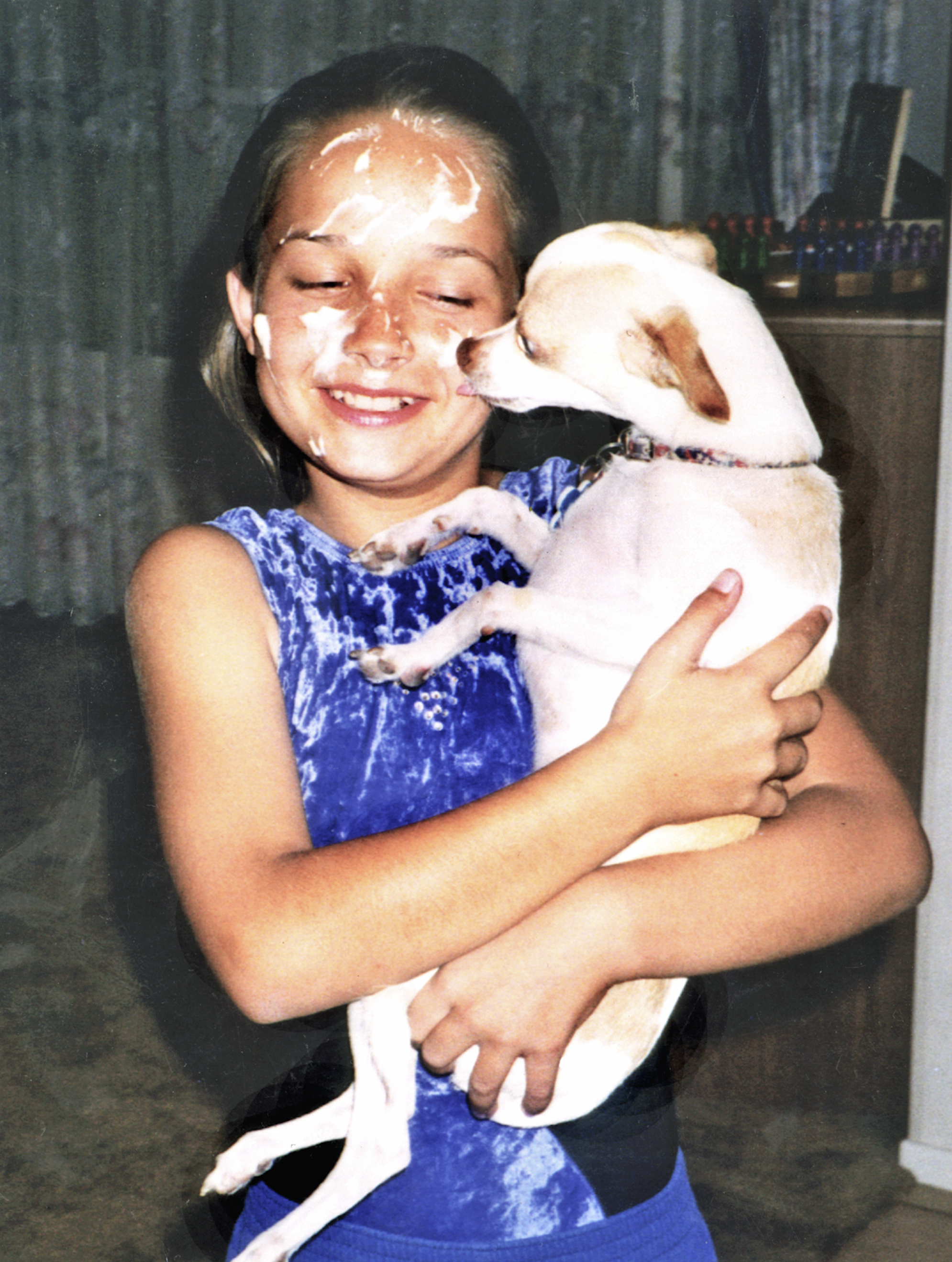The Chase that Killed Kristie
News clips and video about Kristie's Story. Click here.
-
Officers first told the media it was a low-speed, 35 mph chase in a residential neighborhood.
Evidence: In the end and without dispute, the RAV4 had hit our larger Ford Windstar with enough force to propel it some 40 feet, lifting it high enough to ricochet across the top of a chain link fence, spin, and land on its side in someone’s yard. After the Chico Enterprise-Record made a legal request for information about the pursuit, the police said the speed of the pursuit was probably 45 mph. In the police report, the girl said she was going over 65; her friends said "very fast." Witnesses reported the speed as 45 mph, 50-55 mph. -
Policy dictates that "a pursuit shall be abandoned if it is traversing traffic-controlled intersections."
Evidence: Information in the police documents about this chase reveals officers chased the teen through five stop signs. The first was a one-way stop way and the remaining four were two-way signs. Thus, in all traffic-controlled intersection, the fleeing driver and police had the stop signs, while those traveling on intersecting roads, such as the Prianos, had the right of way. -
Officers told the media the pursuit was necessary to recover a stolen car.
Evidence: Information in police documents proves the following: Prior to the chase, officers knew the driver's name and address and that she had taken her mother's SUV without permission.
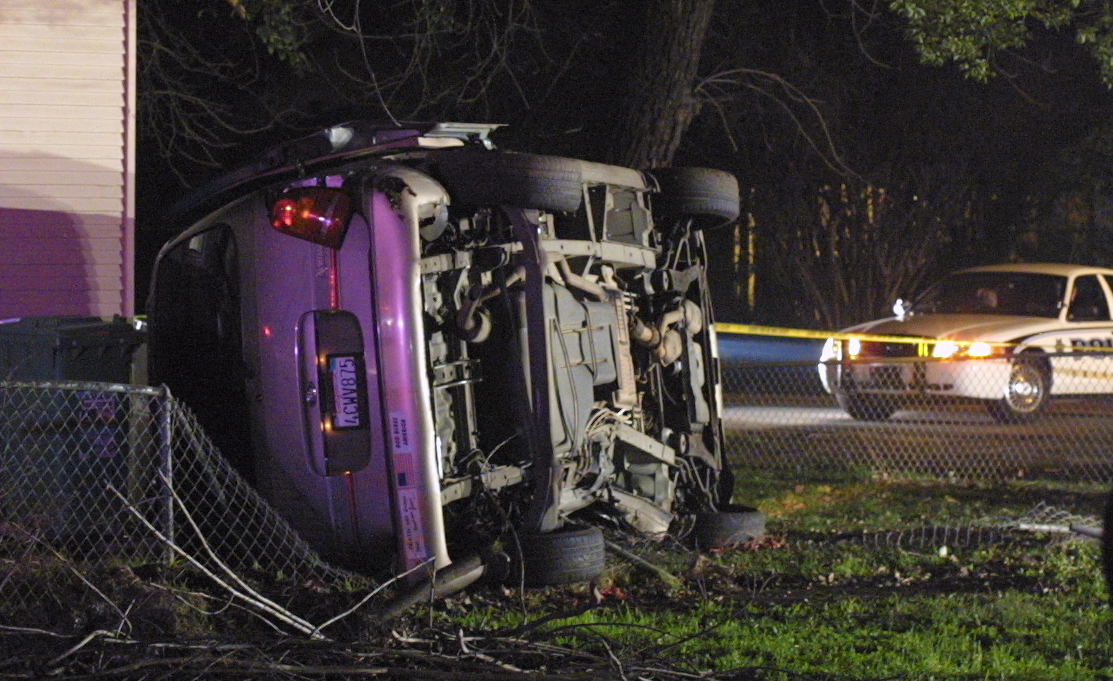
The van sailed through the air, spinning around and around. When it finally came to a rest, the van was 40-feet from the intersection next to a house.
Chico's Pursuit Policy vs. Chico's Police Report
Most fleeing suspects are back home before the officer finishes his/her paperwork.
To read "Protect and Serve," click here.
Many, if not most, fleeing suspects are minor traffic offenders.
Restrictive pursuit policies encourage officers to catch suspects who flee in a different way that's safer for innocent bystanders and peace officers.
According to the Chico Police Department's reports of the chase the unlicensed teen's driving (prior to the chase) posed no imminent risk to public safety. She was not speeding, and she was not running stop signs. Prior to the chase, officers knew the teen's identity and that she had taken her mother's car without permission, but officers told the media that officers initiated the pursuit to recover a "stolen" vehicle.
Of course the teen should have stopped and is partially responsible for Kristie's death. But equally responsible are the involved officers, including the command supervisor because they did not follow their own department's pursuit policy. For policy information on pursuit objectives & priorities, click here.
Chico PD first told the media the pursuit was to recover a "stolen" RAV4 and that it was a low-speed chase, only 35 mph, at night through a residential neighborhood. When the Chico Police would not release any information about the chase, the Chico Enterprise-Record made a legal request to obtain this information.
Once the police report was made public, we read from the report that the teen said she was going approximately 65 mph and her two friends said "very fast." Witnesses reported the speed as 45 mph, 50-55 mph. To read the police report on this information, click here.
Lisa Lewis, executive director of Crash Prevention in Washington, D.C., said, "All vehicles are required to protect passengers from side impacts up to 33.5 mph. If the impact was at 35 mph, Kristie would have received minor injuries, instead of the massive head trauma that caused her death."
The Chico police made no effort to terminate the pursuit even when it became obvious that the risk to the surrounding public was greater than the seriousness of the teen's crime (violation of policy). Multiple patrol cars—witnesses say four cars (violation of policy, click here)—continued chasing the teen through a residential neighborhood at night on narrow streets, with poor lighting and low visibility (violation of policy). The street where the crash occurred had no curbs or sidewalks and huge oak trees filled the corners.
Seconds before the crash, the command supervisor told officers: "If it gets reckless, I'm going to call it off."
This statement was made after excessive speeds, and four stop signs run (violation of policy, click here).
Mark and Candy Priano asked:
"This wasn't reckless enough?"
The teen was chased down Palm Avenue which has multiple two-way stop signs; intersecting streets such as the one we were traveling on had no stop signs.
Retired Bellevue, Washington State Police Chief Donald Van Blaricom said, "This kind of situation is like playing Russian roulette with a loaded gun. Sooner or later you're going to hit a loaded one."
The officers were not disciplined for violating their pursuit policy which also states that if the identity of the suspect, especially a juvenile, is known and the suspect can be caught later, then the officer should abandon the pursuit, especially if the risk to the public is greater than the need to apprehend the suspect.
During a public meeting before Chico's Internal Affairs Committee, Mark and Candy Priano asked the city to tighten its pursuit policy. Chico Police Chief Bruce Hagerty said a Chico police sergeant reviewed the pursuit and determined that it was "valid and controlled." Hanging in a moment of silence, I wondered how this pursuit could be "valid and controlled" when the only person to die was an innocent, young girl—a loving daughter, devoted sister, honor student, class officer, athlete, and community volunteer.
Chief Hagerty also said, "The police officers did follow policy. And as pursuits go, this is as controlled as you can get."
Additional detailed information is from a typed document of the radio communication between officers involved in the chase and the command supervisor. The radio communication is a typescript, not an unedited recording.
In a news broadcast, a Chico police lieutenant tells the reporter three things that were later shown to be false:
• They chased the teen because the car was stolen.
• The speed of the pursuit was 35 mph.
• Officers followed their pursuit policy.
From a typed radio communication: Prior to the chase, Chico PD received a call from the teen's mother who told them that her daughter, 15, had taken her car without permission. She gave them her daughter's name, age, and address. The mother also told them that her daughter was probably going to a friend's house and gave them the address.
The officer arrived moments after the teen pulled away from the house. The officer attempted to pull her over. Certainly the officer who tried to pull the teen over in a residential neighborhood had to consider before he even put on his lights & siren that the teen might not pull over appropriately.
From a Chico E-R news story: At first it appeared as if she was going to stop, but according to Capt. Mike Maloney (who was not one of the officers involved in the pursuit), she changed her mind. The radio typescript does not support Maloney's statement.
Per Chico's Pursuit Policy
Officers are NOT (caps in policy) obligated to continue any pursuit,
taking into consideration such items as (items in bold are in the policy):
• Driver of the vehicle being pursued is known or believed to be a juvenile whose identify can be ascertained. Chico's pursuit policy advises officers to catch juveniles later if they know the juvenile's identity. The officers knew prior to initiating the pursuit that the driver was a teenage girl. They knew her identity and address, so it was highly likely that the teen could be found at a later time.
• Roadway Conditions. This pursuit took place in a residential neighborhood with narrow, poorly lit streets with poor visibility at the intersections. Anyone who has driven through The Avenues knows that Fifth & Palm is a blind intersection with no curbs or sidewalks and large trees on the corners.
• Speeds: This pursuit was in excess of posted speeds. As noted in the police report, witnesses reported the speed as 45 mph, 50-55 mph on Palm Avenue. The teen said she was going at least 65 mph (not 35 mph as reported in the first news broadcast). Also, the director of Crash Prevention in Washington, D.C. said, "If the chase had been at 35 mph, Kristie would have received minor injuries instead of the massive head trauma that caused her death."
The fleeing teen hit our van directly where Kristie was sitting. Kristie's dad, Mark, who was on the same side of the van as Kristie, was in ICU for almost 24 hours. His physical injuries were serious but not life threatening. My son, Steven, and I received physical injuries and never ending heartbreak.
• Numbers and ages of bystanders and other motorists (their safety). A pursuit at high speeds on a dark January night through 100 percent residential streets was a threat to the safety of other motorists and pedestrians.
Chico's Pursuit Policy states, "A pursuit shall be abandoned if it is traversing traffic-controlled streets, congested, narrow or blind streets." The police chased the teen down multiple streets with two-way stop signs that were ignored, while intersecting streets such as the one Kristie's family was driving on had no stop signs.
• Totality of the circumstances. This was a teenage driver whose identity was known and who had taken her mother's car without permission. This was not a suspected or convicted felon. The girl had no record.
• The reasonableness of continuing the pursuit. A quote from State Senator Sam Aanestad: "An innocent child in my district was killed in a high-speed police pursuit, and the police weren't even after some violent, dangerous criminal. They were chasing a teenage girl for driving her mother's car without permission. There's something very wrong when the police response to a crime poses a greater threat to public safety than the crime itself."
California grants law enforcement departments immunity for simply adopting a pursuit policy, but officers and the public entity that employs the officers are not held accountable when the officers do not follow the policy they have actually adopted.
People have asked the Prianos, why didn't you pull over. "We did not hear or see anything—no sirens, no flashing lights. Two police officers and a pursuit expert have answered this question for us. Read their answers in the Ten Deadly Myths and One Fact why unnecessary police pursuits will continue, click here.
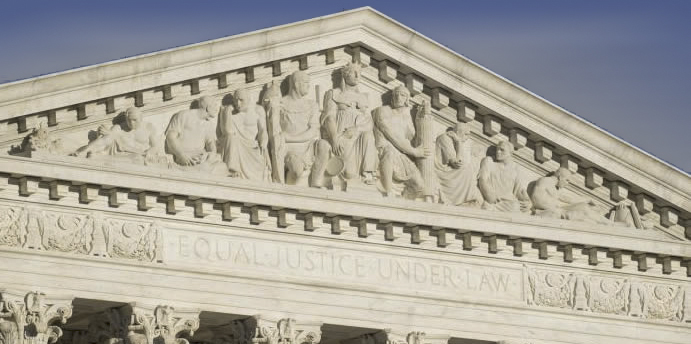
Supreme Court Rulings
(Click to read federal and state cases.)
Protect and Serve ... ALWAYS
(Click to read officer's message.)
Two more images of the ...
Priano's van
after the crash
This crushed side is off the frame and pushed deep into the van's interior, forming a V-shape, right where Kristie was sitting on the inside of the van. The chassis is 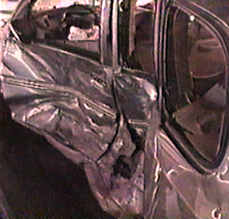 not intact.
not intact.
The van's frame and supports are destroyed, with welds and rivets on the other side. The van's top is split and popped.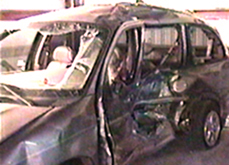
Chico Police Officer
Jim Parrott's
(Click to read officer's letter to the editor and the Prianos' response to his letter.)
An investigative article
written by a police officer
"All pumped up"
written by a police officer
"All pumped up"


